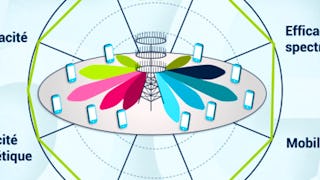This course focuses on advanced, yet essential concepts, techniques, and algorithms needed for understanding and designing modern wireless communication systems. You will begin this course by exploring the basics of wireless channels, followed by the need for multi-antenna systems. You will further learn about the two seminal multi-antenna technologies: MIMO and massive MIMO. The first is the basis for 4G systems, and the second is the same for 5G systems. You will also learn the multiple access techniques like orthogonal frequency division multiplexing (OFDM) and non-orthogonal multiple access (NOMA) and the basics of mmWave communications .
Profitez d'une croissance illimitée avec un an de Coursera Plus pour 199 $ (régulièrement 399 $). Économisez maintenant.

Expérience recommandée
Ce que vous apprendrez
Explain the fundamentals of modern wireless communication, such as 4G and 5G systems.
Describe the essential theories related to their critical technical advancements related to 5G.
Comprehend the challenges in realizing them and the way forward.
Compétences que vous acquerrez
- Catégorie : Algorithms
- Catégorie : Digital Signal Processing
- Catégorie : Mathematical Modeling
- Catégorie : Network Architecture
- Catégorie : Digital Communications
- Catégorie : Wireless Networks
- Catégorie : Communication Systems
- Catégorie : System Design and Implementation
- Catégorie : Telecommunications
Détails à connaître

Ajouter à votre profil LinkedIn
15 devoirs
Découvrez comment les employés des entreprises prestigieuses maîtrisent des compétences recherchées

Il y a 13 modules dans ce cours
This module provides an overview of the course content and structure. In this module, you will learn about the different course elements. In this module, you will get acquainted with your instructor and get an opportunity to introduce yourself and interact with your peers.
Inclus
3 vidéos1 lecture1 sujet de discussion
In this module, you will learn about the basics of wireless communication. We will try to answer a few questions, such as why wireless and what are the applications of different generations of wireless technologies. The module also discusses the system model for a wireless channel which will form the foundation for all mathematics carried out in this course.
Inclus
9 vidéos5 lectures2 devoirs1 sujet de discussion
In this module, you will learn about multi-antenna wireless systems. The module will discuss different antenna configuration setups, such as the single-input multiple-outputs (SIMO), multiple-input single-output (MISO), and the multiple-input multiple-outputs (MIMO) . You will learn how to derive the bit-error rate of a multi-antenna system. This module will also discuss various receive combining techniques.
Inclus
5 vidéos1 lecture
This module focuses on the capacity analysis for a multi-antenna system. You will learn how to calculate the capacity of single-input single-output (SISO), single-input multiple-output (SIMO), multiple-input single-output (MISO), and multiple-input multiple-output (MIMO) systems.
Inclus
4 vidéos2 lectures2 devoirs1 sujet de discussion
This module focuses on how received signals are demodulated with and without the channel state information and which kind of receiver performs well under different scenarios. You will also learn about the different channel assumptions, such as fixed channel, no channel information at the transmitter/receiver, slow-fading channel, and fast-fading channel.
Inclus
3 vidéos1 lecture1 sujet de discussion
This module will focus on ways to increase a cellular network’s overall throughput. The module analyses the spectral efficiency for different configurations of cellular networks, for example, single/multiple-antenna at the base station, single/multiple users in a cell, and two-cell/multiple-cell in a cellular network . You will gain insights into which network configuration best suits maximizing the area throughput. The impact of the increase in antenna/users/cells will be discussed in detail, with spectral efficiency as the metric. The module will consider different channel settings, such as line-of-sight and non-line-of-sight. Also, you will learn how antenna placement affects channel modeling.
Inclus
7 vidéos3 lectures2 devoirs
In this module, you will work on the first project of the course. This project is based on the concepts covered in Week 1-Week 3. This module provides the tasks required to complete the project, instructions to complete and submit the assignment, and the criteria for how your instructor will grade your submission.
Inclus
1 devoir
This module will act as a bridge between multi-user MIMO and massive MIMO systems. The module will explain when a multi-user MIMO system can be called a massive MIMO system. You will learn about different properties of massive MIMO, for example, channel hardening and favorable propagation. You will learn why channel estimation is an important aspect, mainly when you consider a massive MIMO system. The focus will be on how to calculate an estimate of channels with limited overhead. Further, it will discuss different ways to estimate channels, such as the minimum mean square error (MMSE), least-square (LS), semi-blind, and superimposed channel estimation techniques.
Inclus
6 vidéos2 lectures2 sujets de discussion
In this module, you will learn the need to shift the operating frequency bands of the upcoming wireless systems towards the mmWave frequency bands. You will also learn the challenges involved in realizing such systems. Subsequently, you will learn to characterize the mmWave channel models, specifically the narrowband and wideband models. Later, you will be exposed to the key design consideration for modeling a mmWave system.
Inclus
3 vidéos2 lectures
In this module, you will understand the role of beamforming in a wireless system. You will begin by learning the three beamforming architecture types: analog, digital, and hybrid. Subsequently, you will be exposed to modeling the uplink and downlink systems utilizing these beamforming architectures. Lastly, you will comprehend the beamforming objectives and learn a few selected algorithms for achieving the same.
Inclus
3 vidéos2 lectures2 devoirs
In this module, you will learn how the channel property changes and causes an inter-symbol interference when we start realizing a wideband system, resulting in severe performance degradation. You will further learn how a multi-carrier modulated system can combat such degradation and pave the way for a widely accepted and commercialized technique known as “orthogonal-frequency division multiplexing (OFDM).” The module will discuss the OFDM system model and its performance characterization. Subsequently, the model will be extended for a multiple-input multiple-output (MIMO) system. You will also learn a few of the selected realization issues of the OFDM system.
Inclus
9 vidéos5 lectures2 devoirs1 sujet de discussion
In this module, you will learn how introducing an overlapping (i.e., a non-orthogonal) resource allocation can help in improving the overall throughput of the wireless system. The first part of the module will describe the basics of non-orthogonal multiple access (NOMA), considering a two-user scenario. The focus will be on developing an understanding of its transmitter and receiver structure and the constituent algorithms. Subsequently, the second part of the module will extend the idea to multi-user scenarios and multiple antenna cases. Lastly, this module will discuss a few of the other popular forms of NOMA.
Inclus
6 vidéos3 lectures2 devoirs1 sujet de discussion
In this module, you will work on the second project of the course. This project is based on the concepts covered in Week 4-Week 6. This project includes two parts: Part I and Part II. Part 1 is an auto-graded quiz. Part II is a staff-graded assignment, which will be evaluated by the instructor.
Inclus
1 vidéo2 devoirs
Instructeurs


Offert par
En savoir plus sur Electrical Engineering
 Statut : Prévisualisation
Statut : PrévisualisationYonsei University
 Statut : Prévisualisation
Statut : PrévisualisationInstitut Mines-Télécom
 Statut : Essai gratuit
Statut : Essai gratuit Statut : Prévisualisation
Statut : PrévisualisationQualcomm Academy
Pour quelles raisons les étudiants sur Coursera nous choisissent-ils pour leur carrière ?




Foire Aux Questions
To access the course materials, assignments and to earn a Certificate, you will need to purchase the Certificate experience when you enroll in a course. You can try a Free Trial instead, or apply for Financial Aid. The course may offer 'Full Course, No Certificate' instead. This option lets you see all course materials, submit required assessments, and get a final grade. This also means that you will not be able to purchase a Certificate experience.
When you purchase a Certificate you get access to all course materials, including graded assignments. Upon completing the course, your electronic Certificate will be added to your Accomplishments page - from there, you can print your Certificate or add it to your LinkedIn profile.
Yes. In select learning programs, you can apply for financial aid or a scholarship if you can’t afford the enrollment fee. If fin aid or scholarship is available for your learning program selection, you’ll find a link to apply on the description page.
Plus de questions
Aide financière disponible,



